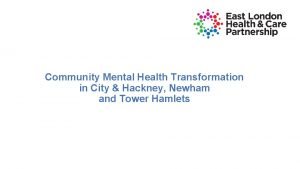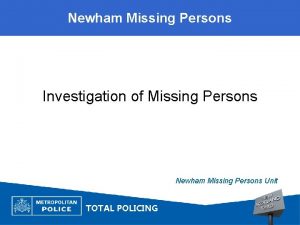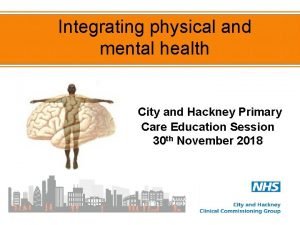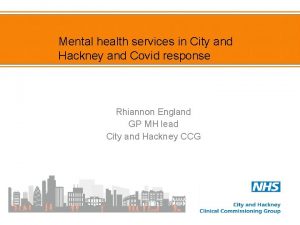Community Mental Health Transformation in City Hackney Newham









- Slides: 9

Community Mental Health Transformation in City & Hackney, Newham and Tower Hamlets

Key features of our bid Five key design principles have guided our model’s development: 1. Service users and citizens will be active, equal partners: leading the design, implementation, governance, and delivery of our new model 2. We will integrate mental and physical health, wellbeing and social care: our services will feel fully integrated to service users and carers 3. The right support in the right place and the right time: services will be delivered in the PCN footprint, and service users will not be “bounced around” services 4. A focus on what matters to service users: care planning will look beyond health goals to life goals and wider determinants of health; and we will work to connect people to each other and their communities 5. Evidence-based interventions: Service users will be confident that our services provide the latest evidence-based care, treatment and support. Key enablers: • • Our biopsychosocial assessment and care planning processes, structured around Dialog Plus, will address social care as well as health needs, ensuring residents will not require a separate assessment under the Care Act 2014 Multidisciplinary (multi-agency) MH teams organised around PCNs, including: psychiatrists, psychologists, nurses, social workers, peer support workers and community connectors working in partnership with primary care clinicians, social prescribers, clinical pharmacists and community health services We will use our RCPsych accredited Peer Support Worker Training to increase our faculty of PSWs A workforce strategy that utilises apprenticeships; blends clinical and non-clinical roles; and provides job opportunities for local citizens

Developing neighbourhood models for mental health

Our proposed model on a page

Areas of increased focus Adults with a diagnosis of personality disorder • Much clearer PD / complex trauma pathway, with significant additional clinical and non-clinical staff working as part of a PD specific offer to PCN populations • Our pathway will include locally delivered support networks led and delivered by people with PD – service user networks will provide peer support, increase participation, connection to community, and thereby reduce social isolation Adults at risk of developing an eating disorder • We will develop a pre-diagnostic service (focused on pre-ICD 10 Eating Disorder diagnostic threshold patients and the mild end of the spectrum) to complement the existing services in our patch • The service will be co-developed with experts by experience, and we anticipate their input into the delivery of the service through opportunities such as being group co-facilitators Young adults (18 -25) • We will build on the good practice in existing transitions planning between CAMHS and adult MH services (particularly EIP Teams) by developing young adult (YA) or transition specialists within the specialist community teams at place-level • PCN teams will contain YA specialist posts to lead on assessment, support planning and peer support for 18 -25 s; and support will be offered at locations that are most meaningful to the service user e. g. university campuses, youth hubs • We will actively promote opportunities for YAs to pursue careers in MH; establishing a pathway for Peer Support Workers to take up paid Community Connector or other non-qualified roles within our staffing structures Working age adults • Our Community Connectors, Support Workers and Peer Support Workers will flex between those whose needs are reducing; and those whose needs are increasing. This approach will particularly benefit people who struggle to navigate VCS and universal services on their own • We will co-design intuitive pathways to employment from both within the PCN teams and our place-based specialist teams. These pathways will incorporate third sector, council and DWP funded support for adult training and education Older adults • Where there is a care home within the PCN, the PCN MH Team will provide MH consultancy support to the home, as part of the more general PCN MDT offer • There will be Community Connectors with a specific brief to support older adults to connect with opportunities available in local community settings • Our PCN teams as part of the broader PCN MDT will proactively engage with paid and unpaid carers, and will be trained on how to manage expectations, and hold difficult conversations

Programme aims - what have we said we want to achieve?

Programme aims - what have we said we want to achieve?

Centrally determined Programme methodology MEASURES OF SUCCESS AIM Locally determined CITY & HACKNEY PCN PCN PCN EVIDENCE BASE (e. g. NICE) TOWER HAMLETS PCN Innovation in design & delivery PCN MUST-DOs PCN PCN NEWHAM PCN Innovation in design & delivery PCN PCN EVALUATION CRITERIA PCN PCN PCN Innovation in design & delivery PCN LEARNING NETWORK & COMMUNITY OF PRACTICE PCN PCN

Programme methodology • 3 part data review: • People with lived experience • People / services in touch with population • Quantitative data Define the population Statement of purpose (aim) • Why are we doing this? • What are we hoping to achieve? • How will we know if we’ve achieved our aim? • How will we measure impact? Measures of success Programme plan / tasks • Implementation plan for each place-based system • Overarching ‘mustdos’ vs. local change theory

















